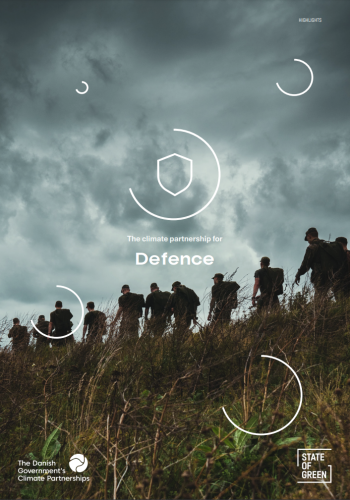The challenge
Today, the overall emissions of the Danish defence sector are approximately 254,000 tons CO2e. The defence sector covers a wide range of elements across most sectors. It is both an operator of aircrafts, ships, and vehicles, as well as a transportation and logistics organisation and an education facility. Furthermore, it is a landowner and a building administrator.
At the same time, defence forces need to function under the most difficult and dangerous conditions. Since it needs to wor...
Today, the overall emissions of the Danish defence sector are approximately 254,000 tons CO2e. The defence sector covers a wide range of elements across most sectors. It is both an operator of aircrafts, ships, and vehicles, as well as a transportation and logistics organisation and an education facility. Furthermore, it is a landowner and a building administrator.
At the same time, defence forces need to function under the most difficult and dangerous conditions. Since it needs to work both in times of peace and crises, the dilemma is how to reduce emissions and at the same time increase operational efficiency, security of supply and enhance the safety of soldiers.
The potential
The potential is not yet defined.
To date, the Danish Ministry of Defence (MoD) has concentrated its green transition initiatives within the ministerial department, the MoD Estate Agency and the MoD Acquisition and Logistics Organisation, and only to a very limited degree in Defence Command Denmark, the Home Guard and the Emergency Management Agency. A climate action plan and annual climate accounts have been prepared. The accounts are based on available data but not broken down by act...
The potential is not yet defined.
To date, the Danish Ministry of Defence (MoD) has concentrated its green transition initiatives within the ministerial department, the MoD Estate Agency and the MoD Acquisition and Logistics Organisation, and only to a very limited degree in Defence Command Denmark, the Home Guard and the Emergency Management Agency. A climate action plan and annual climate accounts have been prepared. The accounts are based on available data but not broken down by activity.
The MoD currently has no general strategy that sets targets and a direction for activities on Defence as a whole, nor does it contribute to the annual reports on the government’s climate initiatives, which take stock of climate progress in Danish state organisations.
Recommendations
- In the future, the Danish Defence must use Power-to-X-based fuels for propulsion and must therefore be linked to current private sector initiatives intended to build production and supplies.
- Until the Power-to-X technology matures, the Danish Defence must test the use of alternatives such as bio-fuels via the advances taking place in the civilian aviation industry and the maritime domain.
- The consequences of conversion to alternatives must be clarified.
- Existing platforms must be optimised using tools from the civilian sector
- It must be clarified if experience from optimising navy vessels – using both civilian and military expertise – can be used as an ‘export commodity’ based on a given model.
- A long-term strategy is to be prepared for how Danish design, energy optimisation and ship production can make the Danish navy greener by 2050 and generate export opportunities.
- Denmark must develop new sophisticated opportunities for using simulation and virtual reality as an alternative or supplement to live training and education.
- The use of simulation and virtual reality technology must be combined with the development of new learning concepts that ensure maximum, effective training transfer. The solutions should be internationally promoted.
- A concept should be designed for setting up green camps that as far as possible are self-sufficient in water, electricity, circular waste management, etc.
- Ways of enabling the MoD to take on and jointly operate other green operational concepts with industry should be explored.
- It is recommended that further funds be injected into the MoD’s co-financing scheme for research and development and earmarked for promoting green solutions.
- It is also recommended that established innovation networks for green defence be used for purposes such as addressing challenges or ideas in the green arena
- Existing administrative vehicles are to be replaced with electric ones, and an infrastructure to support their operation is to be established.
- Heavy transport is to be made more efficient, with inspiration from developments in the civilian sector.
- The armed forces should follow the civilian sector’s development of future transport options (incl. drones, etc).
- The ESCO model is to be used to optimise buildings, where savings generated finance private consultancy and implementation of measures to reduce energy consumption and CO2
- The construction and operation and maintenance of new buildings is to be managed by new types of public-private partnerships with focus on optimisation, financing and efficient use.
- Introduce environmental and climate requirements for all procurement, prioritise green profile in the tender processes, and examine the climate impact of acquisitions.

The Climate Partnership for Defence
Want to learn more about the climate partnership and explore the government and industry recommendations more in-depth? Fill in your information below and download the highlights
Chairman
Poul Skadhede, Chair of OMT
Vice chairman
Steven Friberg, CEO, UXV Technologies
Private partners
- Confederation of Danish Industry
- Danish Chamber of Commerce
- CenSec
- Danish Maritime
- Naval Team Denmark
Public partners
- Ministry of Defense
- Ministry of Industry, Business and Financial Affairs
- Ministry of Research and Education
- Ministry of Climate, Energy and Utilities
- Ministry of Foreign Affairs

